This article was co-authored by Kate Jutagir. Kate Jutagir is an Equestrian Specialist, Hunter/Jumper Trainer, and the Owner of Blackhound Equestrian, a premier training barn located on 65 acres in Castro Valley, California. Originally designed to be a riding school used as a springboard for dedicated students into careers in the sport, Blackhound Equestrian has grown into a hunter/jumper training program for all levels focusing on providing a solid foundation needed for personal advancement in the sport. Kate has over 25 years of equestrian instruction and training experience. Her focus on developing horse and rider partnerships provides a complete equestrian education for both beginners and advanced riders alike.
wikiHow marks an article as reader-approved once it receives enough positive feedback. In this case, several readers have written to tell us that this article was helpful to them, earning it our reader-approved status.
This article has been viewed 111,025 times.
Horses are intelligent, hard-working animals that make great companions. However, it's easy to forget that they are also large, powerful animals that can be dangerous if they're startled or provoked. By obeying a few simple rules of horse safety, it's easy to show care and respect for your animal without too much extra effort.
Steps
Approaching a Horse Safely
Note: If you are inexperienced with horses, work with a horse expert. Don't approach an unfamiliar horse without asking its owner first.[1]
-
1Familiarize yourself with basic horse body language. It's very important to be able to tell the difference between a happy, inviting horse and an alarmed or frustrated one when you approach the animal.[2] Look for the following signs:
-
Comfortable signs (if you see these, proceed):
- Having relaxed, "soft" eyes that aren't staring at you
- Turning his head or front quarters toward you
- Licking his lips
- Ears pricked towards you.[3]
- Having a peaceful, relaxed overall body position
-
Uncomfortable signs (if you see these, back off and do not approach):
- Moving or running away from you as you approach
- Having intense, wide eyes or eyes that are staring at you[4]
- Pinning his ears (moving them back against his head)[5]
- Tense muscles[6]
- Bearing his teeth or trying to nip at you[7]
- Rearing up on his legs or kicking[8]
- Flicking tail repeatedly in aggressive fashion, often with back legs stomping.
-
Comfortable signs (if you see these, proceed):
-
2Always be aware of where the horses are. It takes only a moment for a horse to run up behind you and possibly rear up on you. Make sure you can see where the horses are and keep watch. Horses can get startled by almost anything. If a horse seems to be running towards you, to make sure you don't get trampled raise your arms to appear larger and say in firm calm, voice "whoa" or "get". This will help with getting the horse to head another direction.Advertisement
-
3Create an inviting rather than demanding presence before you approach. With horse behavior, there is an idea of pressure and release. Horses are herd animals, and will most likely not stand in an area waiting for you to approach them. Simple things, such as making eye contact, is actually putting pressure on the horse, cueing him to move away from you.
-
4Approach the horse diagonally from the front whenever possible. The number one rule for approaching horses is to make sure that they know you're coming. This is easiest (by far) if you come at the horse from the front and slightly to the side (to avoid the blind spot right in front of it). If you can, approaching from the front-left of the horse is even better: many horses are trained specifically to work with humans on their left side and as a result are most comfortable with this.[9]
- It actually is a myth that horses prefer one side over the other. It is us humans that over the years have developed a habit of doing everything from the left, training and desensitizing to the left, but forgetting about the other side. A horse will approach one another in the wild without a care in the world about which side they are approaching. You do, though, want to make sure you are setting both you and the horse up for success.
- Use a gentle, even walking pace. Try to stay relaxed, as horses are good at picking up on subtle signs of tenseness. Make no effort to hide yourself or the noise of your feet.
- Don't stare the horse in the eyes. This can be interpreted as a threat. Instead, look at its knee as you approach.
-
5If you have to approach from the rear, approach at an angle. Note that this should be avoided by anyone but experienced trainers with knowledge of drive lines. Approaching a horse from a direction other than from the front isn't ideal — just like it can be uncomfortable for someone to approach you from the rear, this can be unsettling for the horse. To make the animal as comfortable as possible, come at the horse from an angle (not from directly behind it). The wider the angle, the better: horses have monocular vision, which means they can use each eye separately to see you on their sides.[10]
- As mentioned above, the horse's left side is generally preferable to the right.
-
6Use your voice to let the horse know you're approaching. To first-time riders, hearing an experienced horse handler talk to her horse constantly can seem unusual. However, this serves an important purpose: it lets the horse know where the human is at all times. As you approach the horse, call to it at a gentle volume. You can say basically anything you want here as long as it's in a non-threatening, even tone, but most riders simply say things to the effect of, "Hey, horse, are you ready to ride?"
- You should do this no matter what direction you approach the horse from, but it's even more crucial if you're forced to approach the horse from a direction besides the front. Since the horse may not see you right away, it's important to let it know you're coming with your voice.
-
7Let the horse smell you. Like dogs and many other animals, horses use their powerful sense of smell to identify other animals and detect threats. When you reach the horse, hold your hands out for it to smell. Don't thrust your hands right into its nose — instead, stand a step or two in front of it and gently move your hands (palms pointing down and held flat and open) to about a foot in front of it.
- If the horse doesn't seem to want to smell your hands, don't continue to bother it. Instead, just withdraw your hands and continue to the next steps.
-
8Give the horse a small treat if you have one, and if you have permission from the horse's owner. This isn't required, but it's helpful for getting an unfamiliar horse to "warm up" to you. One of the greatest dietary dangers for horses is bloat, which can often become fatal, so it's good to err on the side of caution and check with the horse owner before offering their horse a treat.
- Apples, carrots, and horse treats are all great options.[11]
- Bloat can be created by several factors, some of which include even small amounts of foods that horse is not used to eating, foods that the horse could be allergic to, or, foods that are eaten at the wrong times. A few processed foods, or even some wild plants growing in the area, can be poisonous to horses too. Another consideration is that the owner may have the horse on a specialty diet or medications, and some treats can interfere with with absorption of certain medications or supplements. These are all good and valid reasons to check with the owner before giving their horses a treat.
- Offer your treat to the horse by placing it in your palm, keeping your fingers completely flat. This keeps the horse from accidentally biting your fingers.
- Let the horse take the treat from you. Don't insist on giving it the treat if it doesn't seem to want it.
- Note that treats make some horses snappy - some will become rude very fast if they get treats for no reason, it has to be given immediately after a desirable behaviour AND accompanied by the verbal cue to eat it. It can also lead to horse's refusing to go with you unless you have a treat, not great.
- Small amounts of many common fruits and vegetables make great treats for horses. For example, most horses will enjoy a carrot or a few apple slices.[12]
-
9Pet the horse. Before proceeding to whatever task you have planned for your horse, take the opportunity to show your affection and get it comfortable with you. Move to the horse's shoulder, talking to it as you do so. Make sure it can see you and that it is displaying soft, peaceful eyes. Gently nuzzle it around the neck, shoulder, and mane. You can move down the body to the rump once the horse is comfortable with you. Stay away from sensitive areas like the eyes, nose, and mouth.
- Use a rubbing or a gentle scratching motion — never a slapping or patting motion, which most horses do not like.[13]
Moving to Basic Tasks
-
1Put a halter on the horse. Once you've approached a horse and gotten it comfortable around you, you may want to be able to move it where you want. This is easy with a device called a halter that goes over the horse's nose and mouth. A halter allows you to control a horse's head, leading it where you want it to go.
- Most halters have a small loop that slips over the horse's muzzle with a larger loop that latches either behind the horse's ears or underneath its jaw. Slip a lead rope around the horse's neck before you get started so you'll have something to hold on to if it won't cooperate.
-
2Saddle your horse. A saddle lets you ride a horse by acting as your "seat" on its back. This is something you shouldn't do if you're inexperienced, so don't be afraid to get an instructor's help. Set the saddle down gently and keep the stirrups out of the way so as not to surprise the horse. The saddle should be secured with a girth that allows you to slip two fingers underneath, but not much looser. Don't forget to lay a blanket under the saddle to protect the horse's hair and back.
- There are two popular styles for saddling a horse: Western and English. See the link above for directions on both.
-
3Mount the horse. Mounting the horse just means getting on top of it so that you can ride it. You'll need a horse with a saddle, halter, and set of reins for this. Traditionally, horses are mounted from the left side. Put your left foot in the stirrup with the reins in your left hand. Grab the saddle with your right hand and use a gentle bouncing motion to swing your right leg up and over the saddle. Put your right foot in the other stirrup and grab the reins.
- Have an elevation above the ground for new riders when getting on the horse, like steps or something of the sort.
-
4Ride the Horse. This is it — the moment many horse lovers have been waiting for. Horseback riding is something that entire books have been written about, so we won't even try to explain it all in this article. Click the link for WikiHow's article on how to ride horses, which has detailed instructions for beginners and experienced riders alike.
- This guide is also a great place for beginners to start.
Knowing What to Avoid
-
1Stay out of the horse's kicking range. No matter how much experience you have around horses, there's always the small but real chance that something outside your control may spook the horse. If this happens, you will not want to be within range of the horse's extremely powerful kicks. Most horse handlers do this one of two ways:
- Staying a generous distance away when they are behind or to the side of a horse. Depending on the size of the horse, this "safe distance" can vary, so give the horse plenty of room, especially when directly behind it.
- Staying close to the horse and maintaining contact. Keep a hand on the horse and speak to it with a gentle tone of voice. If you are very close to the horse, it will still be able to kick you, but it won't have enough space to use its full force, so the potential for injury is lower.
-
2Don't make sudden movements around a horse. Keep in mind that it's possible to startle a horse even if it knows exactly where you are. Sudden, violent motion can make a horse think it's in danger and provoke a spook response, so you will want to avoid it at all costs. Specific things to avoid include:
- Thrusting anything into the horse's face (remember that it has a blind spot in front of its nose)
- Running towards the horse
- Slapping or striking the horse in any way
-
3Avoid loud, startling noises. Just like unexpected noises can frighten humans, they frighten horses as well. Don't make loud noises around horses, especially if they're not used to hearing the noise you're about to make. If you do have to do something that makes a loud noise, move away from the horse before doing it. Specific things to avoid include:
- Loud clapping, yelling, or screaming
- Guns being shot
- Loud music
- Loud machines (chainsaws, dirt-bikes, etc.)
- When possible, loud natural noises (e.g., thunder)
-
4Don't surprise or harass a horse when it is eating. Like many animals, horses can be very defensive about their food. However, this is more of a personal tip for a particular horse than a part of a general guideline. If the horse is sensitive about eating, give it plenty of space when it is feeding — even a horse that is normally very docile may get agitated if you interrupt it while it is eating. You should especially avoid putting your hand or anything else near the animal's face or mouth, as this can be interpreted as you trying to steal its food.
-
5Note that there are some things on this list that experienced trainers will do, but generally should be avoided by anyone else.
Expert Q&A
-
QuestionHow can I show my horse I love him?
 Kate JutagirKate Jutagir is an Equestrian Specialist, Hunter/Jumper Trainer, and the Owner of Blackhound Equestrian, a premier training barn located on 65 acres in Castro Valley, California. Originally designed to be a riding school used as a springboard for dedicated students into careers in the sport, Blackhound Equestrian has grown into a hunter/jumper training program for all levels focusing on providing a solid foundation needed for personal advancement in the sport. Kate has over 25 years of equestrian instruction and training experience. Her focus on developing horse and rider partnerships provides a complete equestrian education for both beginners and advanced riders alike.
Kate JutagirKate Jutagir is an Equestrian Specialist, Hunter/Jumper Trainer, and the Owner of Blackhound Equestrian, a premier training barn located on 65 acres in Castro Valley, California. Originally designed to be a riding school used as a springboard for dedicated students into careers in the sport, Blackhound Equestrian has grown into a hunter/jumper training program for all levels focusing on providing a solid foundation needed for personal advancement in the sport. Kate has over 25 years of equestrian instruction and training experience. Her focus on developing horse and rider partnerships provides a complete equestrian education for both beginners and advanced riders alike.
Equestrian Specialist & Trainer Honestly, spending time with them and interacting with them. It doesn't always come down to treats. They don't have the ability to obviously speak to us in a language that we understand. So, the best thing you can do is really work on understanding your horse's language — and they'll let you know pretty quickly what they like and what they don't like.
Honestly, spending time with them and interacting with them. It doesn't always come down to treats. They don't have the ability to obviously speak to us in a language that we understand. So, the best thing you can do is really work on understanding your horse's language — and they'll let you know pretty quickly what they like and what they don't like. -
QuestionWhen haltering a horse, do I clip the lead rope around its neck?
 Community AnswerDo not clip the lead rope but if the horse is prone to struggle with putting a halter on, then loosely hang the lead rope around its neck so that it doesn't make a run for it. When you are done, then simply clip the lead rope to the ring under the chin and remove the rest from the neck. Always hold a lead rope with two hands.
Community AnswerDo not clip the lead rope but if the horse is prone to struggle with putting a halter on, then loosely hang the lead rope around its neck so that it doesn't make a run for it. When you are done, then simply clip the lead rope to the ring under the chin and remove the rest from the neck. Always hold a lead rope with two hands. -
QuestionEvery time I go in the pasture to get my horse he runs away, what should I do?
 Community AnswerApproach him diagonally from the front because he could get nervous if he can't see you well from directly in front. Let him know you're there by speaking calmly to him. You can bring a treat and wait for him to come to you. Follow the rest of the steps in this article.
Community AnswerApproach him diagonally from the front because he could get nervous if he can't see you well from directly in front. Let him know you're there by speaking calmly to him. You can bring a treat and wait for him to come to you. Follow the rest of the steps in this article.
Warnings
- If it's not your horse and the owner is not with you and/or has not given you permission, it's polite to stay away.⧼thumbs_response⧽
- Stay out of a horse's blind spots. These include in front of their nose, underneath their head, under their belly, and directly behind them.[16] If you do have to move into one of these blind spots, make sure the horse knows where you are. Talk to it in a gentle voice and keep one hand in contact with it.⧼thumbs_response⧽
- Don't underestimate the importance of horse safety.[17] The suggestions above aren't just casual tips — they're safety instructions that can save your life. A spooked horse is extremely dangerous. He may start running uncontrollably, lunge suddenly, rear up, or kick. Since adult horses can easily weigh over 1,000 pounds (453 kilograms), any of these things can result in serious injury or even death for you, the horse, and others.⧼thumbs_response⧽
References
- ↑ Kate Jutagir. Equestrian Specialist & Trainer. Expert Interview. 31 March 2020.
- ↑ Kate Jutagir. Equestrian Specialist & Trainer. Expert Interview. 31 March 2020.
- ↑ Kate Jutagir. Equestrian Specialist & Trainer. Expert Interview. 31 March 2020.
- ↑ Jessica Rude. Equine Expert. Expert Interview. 18 September 2020.
- ↑ Jessica Rude. Equine Expert. Expert Interview. 18 September 2020.
- ↑ Jessica Rude. Equine Expert. Expert Interview. 18 September 2020.
- ↑ Jessica Rude. Equine Expert. Expert Interview. 18 September 2020.
- ↑ Jessica Rude. Equine Expert. Expert Interview. 18 September 2020.
- ↑ http://www.equusite.com/articles/safety/safetyBasics.shtml
- ↑ http://www.equusite.com/articles/safety/safetyEyesight.shtml
- ↑ Jessica Rude. Equine Expert. Expert Interview. 18 September 2020.
- ↑ http://www.horsefeedblog.com/2012/06/the-dos-and-donts-of-feeding-treats/
- ↑ http://www.equusite.com/articles/safety/safetyBasics.shtml
- ↑ Kate Jutagir. Equestrian Specialist & Trainer. Expert Interview. 31 March 2020.
- ↑ Kate Jutagir. Equestrian Specialist & Trainer. Expert Interview. 31 March 2020.
- ↑ http://nasdonline.org/document/1043/d000837/approaching-catching-and-haltering-horses-safely.html
- ↑ Kate Jutagir. Equestrian Specialist & Trainer. Expert Interview. 31 March 2020.
About This Article
To approach your horse, approach it diagonally from the front if possible so it sees you coming and you don't startle it. If you have to approach your horse from the back, always approach it from an angle since coming up directly behind it may scare it. Whichever direction you approach from, always call out to your horse in a gentle voice to let it know where you are. For tips on how to saddle and mount your horse after approaching it, scroll down!






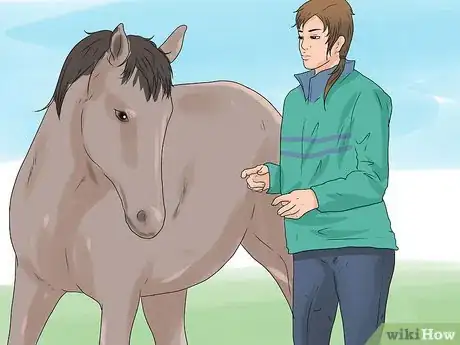
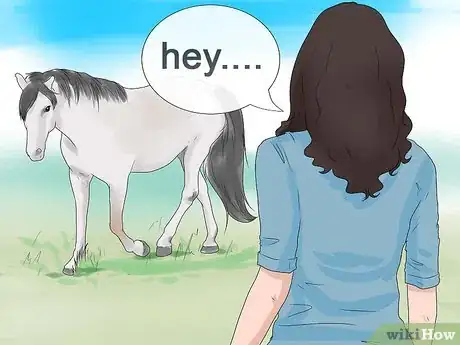

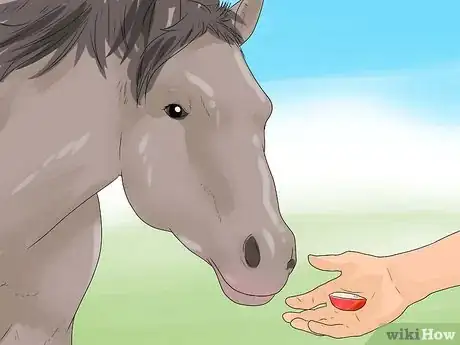
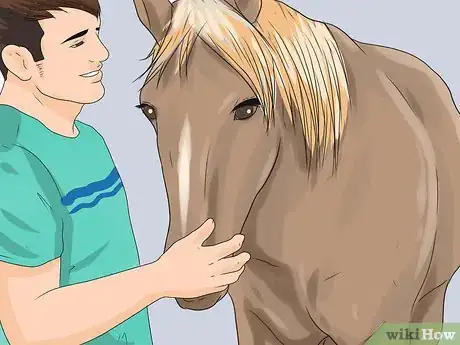





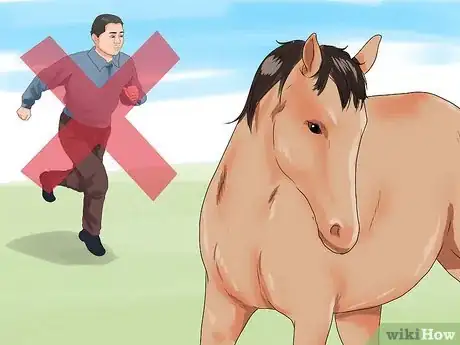
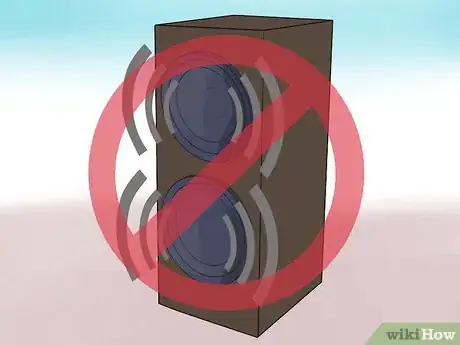

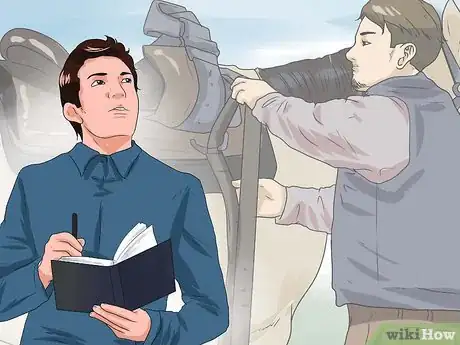


-in-Horses-Step-4-Version-2.webp)
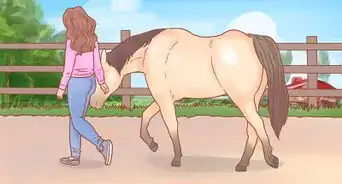


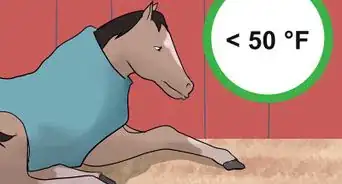













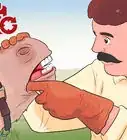
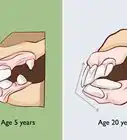

-in-Horses-Step-4-Version-2.webp)


































